The legend of Vishnu, one of the principal deities in Hindu mythology, is a tale that spans aeons, traversing different yugas (ages) of the universe. Vishnu, known as the preserver of the universe, manifests himself in various avatars (incarnations) to restore balance whenever chaos threatens to engulf the world. This epic tale traces the journey of his ten principal avatars, collectively known as the "Dashavatara," as they descend to earth to protect dharma (righteousness) and combat the forces of adharma (unrighteousness). In the beginning, the universe was engulfed in water, an infinite ocean of darkness and chaos. As time passed, the great sage Manu performed penance to gain knowledge and spiritual power. One day, while performing his daily rituals by the river, a tiny fish swam into his hands. Manu, compassionate and kind, placed the fish into his water pot. To his astonishment, the fish began to grow rapidly, outgrowing the pot, then a lake, and eventually the river itself. Realizing the fish was no ordinary creature, Manu prayed for guidance. The fish revealed itself to be the first avatar of Vishnu, Matsya, who had come to warn him of a great deluge that would soon destroy the world. Vishnu instructed Manu to build a massive boat and gather all species of plants, animals, and seven sages, along with the sacred texts. When the deluge arrived, Matsya guided the boat through the tumultuous waters, preserving life and knowledge until the flood receded, marking the beginning of a new age. As time flowed, the devas (gods) and asuras (demons) were locked in a perpetual struggle for power. In search of immortality, they decided to churn the ocean of milk to extract the elixir of life, Amrita. Mount Mandara was chosen as the churning rod, and the great serpent Vasuki became the churning rope. However, as the churning began, Mount Mandara started to sink into the ocean's depths. To save the situation, Vishnu took the form of Kurma, a giant tortoise, and supported the mountain on his back, preventing it from sinking. For countless years, Kurma bore the weight as the devas and asuras continued their efforts. At last, the nectar of immortality emerged, and Vishnu, in another guise, ensured it reached the gods, tipping the balance of power in their favor and preserving the cosmic order. In a subsequent era, the demon Hiranyaksha grew so powerful that he cast the earth, known as Bhudevi, into the cosmic ocean, plunging the world into darkness. As the universe teetered on the brink of destruction, Vishnu descended once more, this time in the form of a colossal boar, Varaha. With mighty tusks, Varaha dove into the ocean, confronting Hiranyaksha in an epic battle. The demon roared, hurling insults and blows, but Varaha's strength was unmatched. With a single thrust, he gored the demon, lifting Bhudevi from the depths and restoring her to her rightful place. This act symbolized the triumph of light over darkness, ensuring the continuation of life on earth. The demon king Hiranyakashipu, brother of Hiranyaksha, was furious at the death of his sibling. Seeking revenge, he undertook severe penance and gained a boon from Brahma, making him invulnerable to death by man or beast, indoors or outdoors, during the day or night, and on earth or in the sky. Empowered by his invincibility, Hiranyakashipu ruled tyrannically, demanding that all worship him as the supreme god. However, his own son, Prahlada, remained devoted to Vishnu, angering the king further. In a fit of rage, Hiranyakashipu challenged Prahlada, demanding to know where his god resided. "He is everywhere," Prahlada replied calmly, pointing to a pillar. Enraged, Hiranyakashipu struck the pillar, and from within emerged Narasimha, Vishnu's half-man, half-lion avatar. Neither fully man nor beast, Narasimha attacked at twilight (neither day nor night) on the threshold (neither inside nor outside) and laid Hiranyakashipu across his lap (neither earth nor sky). Using his sharp claws, he tore the demon apart, ending his reign of terror. The next era saw the rise of Bali, a powerful and benevolent demon king who ruled over the three worlds. Although virtuous and just, his increasing influence threatened the balance of power. To curtail his ambitions, Vishnu appeared as Vamana, a diminutive Brahmin dwarf, during a grand yajna (sacrificial ritual) where Bali was offering gifts to all who asked. Vamana requested just three paces of land, and the generous Bali agreed. To everyone’s astonishment, Vamana began to grow, expanding into a colossal form. With his first step, he covered the earth, and with the second, he spanned the heavens. Having no place left for his third step, Bali offered his own head. Vamana gently placed his foot on Bali’s head, sending him to the netherworld, but not before granting him immortality and allowing him to return to earth once a year to bless his devotees. In the following era, the warrior class (Kshatriyas) became corrupt and oppressive, ruling with an iron fist and exploiting the people. The world cried out for justice, and Vishnu responded by taking the form of Parashurama, a Brahmin warrior with an axe gifted by Shiva. Parashurama embarked on a mission to cleanse the earth of the corrupt Kshatriyas, waging war against them twenty-one times until balance was restored. Despite his formidable strength, Parashurama was not blinded by rage. After fulfilling his mission, he laid down his weapons and retreated to a life of penance, embodying both the warrior’s fury and the sage’s wisdom. The age of Treta Yuga witnessed the birth of Rama, the prince of Ayodhya. Unlike the earlier avatars, Rama was born fully human and lived a life of extraordinary virtue. His tale, the Ramayana, chronicles his journey as a dutiful son, loving husband, and valiant warrior. Exiled to the forest for fourteen years due to palace intrigue, Rama’s life took a tragic turn when his wife, Sita, was abducted by Ravana, the demon king of Lanka. Gathering an army of monkeys and bears, led by the mighty Hanuman, Rama waged a great war against Ravana. After a fierce battle, he finally slew Ravana with his bow, restoring dharma and returning to Ayodhya to rule as a wise and just king. In the Dwapara Yuga, Vishnu appeared as Krishna, the playful cowherd who grew into a cunning strategist and powerful warrior. Born into a world plagued by tyrannical rulers and endless wars, Krishna’s childhood was filled with divine miracles, from subduing venomous serpents to lifting mountains to protect his devotees. As he grew older, Krishna played a pivotal role in the Mahabharata, serving as Arjuna’s charioteer during the Kurukshetra war. His counsel, the Bhagavad Gita, became a timeless guide to life, duty, and spirituality. By the end of his life, Krishna ensured the destruction of the corrupt Kaurava dynasty, thus allowing the rightful Pandavas to ascend the throne. Vishnu's ninth avatar came in the form of Siddhartha Gautama, who would become known as Buddha. Unlike his earlier incarnations, Buddha sought to teach humanity the path of enlightenment and compassion. Through his teachings, he advocated for non-violence, love, and the abandonment of worldly desires. His message spread far and wide, helping countless souls achieve liberation from the cycle of birth and death. Though a peaceful and contemplative avatar, Buddha's teachings played a crucial role in guiding humanity back to the path of righteousness. The final avatar of Vishnu, Kalki, is yet to arrive. According to prophecy, he will descend at the end of the current age, the Kali Yuga, to rid the world of darkness and corruption. Riding a white horse and wielding a blazing sword, Kalki will destroy the forces of evil, restoring balance and paving the way for a new golden age. Thus, the cycle of Vishnu’s avatars is a testament to the eternal struggle between good and evil, light and darkness. In every age, he descends to remind humanity of the importance of dharma and to restore order in the universe. The legend of Vishnu’s avatars continues to inspire countless generations, teaching us that even in the darkest of times, there is always hope for redemption.The Primordial Waters - The First Avatar: Matsya (The Fish)
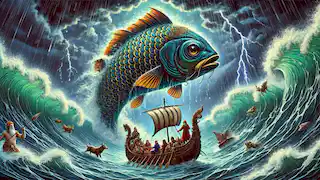
The Battle of Earth and Sky - The Second Avatar: Kurma (The Tortoise)
The Demonic King and the Boar - The Third Avatar: Varaha (The Boar)
The Divine Protector - The Fourth Avatar: Narasimha (The Man-Lion)
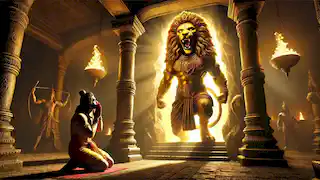
The Humble Dwarf - The Fifth Avatar: Vamana (The Dwarf)
The Warrior Sage - The Sixth Avatar: Parashurama (The Axe-Wielder)
The Prince of Ayodhya - The Seventh Avatar: Rama
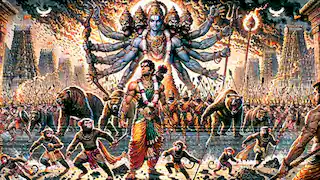
The Cowherd God - The Eighth Avatar: Krishna
The Compassionate Buddha - The Ninth Avatar: Buddha
The Awaited Savior - The Tenth Avatar: Kalki
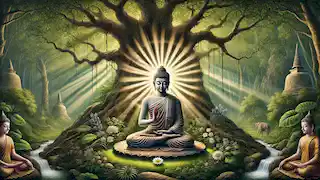
Conclusion
The Legend of the Vishnu Avatars
Reading Time: 8 min
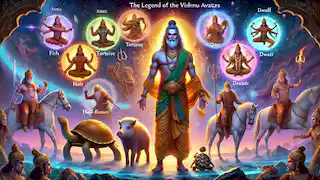
About Story: The Legend of the Vishnu Avatars is a Legend Stories from india set in the Ancient Stories. This Descriptive Stories tale explores themes of Good vs. Evil Stories and is suitable for All Ages Stories. It offers Cultural Stories insights. Vishnu's ten powerful avatars descend through ages to restore balance and preserve righteousness.

















